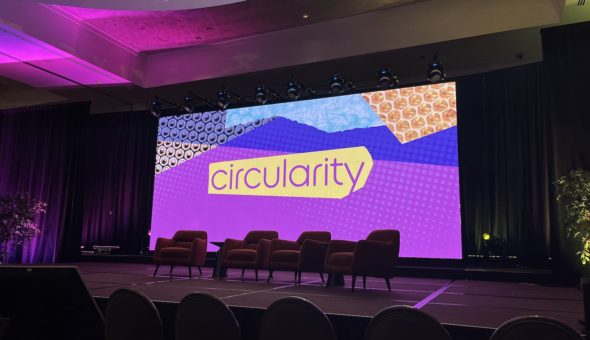This post was contributed by Oli Weber following his attendance at the Hybrid Organic Photovoltaics Conference (28 June - 1 July 2016).
Recently Dom Ferdani (cohort ’14) and I took a trip to the south coast of Wales to attend the 2016 Hybrid Organic Photovoltaics Conference (HOPV 16). The venue was Swansea’s brand new Bay Campus, a huge new development of university buildings sited right by the beach of Swansea Bay. On the first conference day we were met by serious weather blowing in from the sea, leaving delegates from warmer climes wondering what manner of people could be mad enough to inhabit such a cold, damp land. Bay Campus is also the new home to SPECIFIC, the conference hosts, whose mandate is to span the space between academia and industry to develop materials that turn buildings into power stations using functional coatings. Building integrated photovoltaics (BIPVs) are one of the families of technologies developed at SPECIFIC. These rely on thin, lightweight, flexible designs and manufacturing methods, such as printing, that scale up well. Organic semiconductors, dye sensitised solar cells, CIGS and CZTS are all under research and development, however the technology that has come to dominate the research focus for this conference is hybrid perovskite solar cells.

Hybrid perovskites combine the properties of some of the highest quality known semiconductors, such as GaAs, with the solution processability of organic materials. This means that the solar cells could be manufactured at low cost, while still displaying the high efficiency of the best inorganic thin films. Unfortunately the hybrid perovskites are not very chemically stable and are easily attacked and degraded by water. Some of the typical device layers used in perovskite cells may also be contributing to the degradation, so it is still difficult to assess whether these materials will be intrinsically stable, over a 25 year lifetime, if they are properly encapsulated as protection from the environment. It was encouraging to see stability data discussed during the research presentations, particularly in the talk by Professor Mike McGehee of Stanford, whose group is developing semi-transparent perovskite top cells to include directly above standard silicon modules to make a more efficient tandem stack.
Other highlights for me personally were the advanced printing techniques run by SPECIFIC researchers on the day before the conference commenced, when we learnt about the pitfalls that await between laboratory scale work and development of cells suitable for bulk manufacturing at large scale. Professor Laura Herz of Oxford Physics gave an excellent presentation on the amount that can be learnt about charge carrier dynamics within perovskite semiconductors using terahertz photoconductivity and photoluminescence measurements. From the University of Bath, Professor Aron Walsh and Dr Petra Cameron both presented recent research results.
Overshadowing the whole conference was the spectre of Brexit. Many people had learnt the referendum result just before setting out to Swansea. Swansea is one of the areas of the UK that voted to leave despite receiving extensive regeneration funding from the EU; SPECIFIC itself is part EU funded. The research groups present were drawn from diverse international backgrounds and many of the research collaborations, already in progress or spawned during the conference, span the EU and further afield. One thing for certain is that the scientific community will continue to find ways to maintain their international networks and friendships whatever the political landscape. From my point of view (and that of many I spoke to) it’s frankly embarrassing that the referendum campaign was fought, won and lost on the basis of fear, lies and bigotry, drowning out all vestiges of the rational debate scientists thrive on. For a country priding itself on freedom and enterprise, we cannot claim to have a healthy political or media culture.
Sitting on the terrace of the conference hall, the beach ahead of me, it is impossible to ignore the juxtaposition of frenetic scientific activity behind me, as brilliant people from every part of the world work to develop clean energy sources for the future, with the EU and Welsh flags taut in the sea breeze just in front and, visible further along the coast, Port Talbot steelworks, in the news as 4,000 people wait on tenterhooks to hear if their livelihoods will disappear. Swansea is an area already hard hit by disappearing traditional industries, on the sharp end of globalised trade. The referendum vote has already delayed and could wreck buyout bids to retain the steelworks, with 69% of Welsh steel exported to the EU. Projects like SPECIFIC serve a dual purpose, for research and as attempts to sow new seeds of industrial activity for clean technologies for the twenty first century. If and when the UK regains political leadership, it will be up to UK government to prove it can support these activities as well as the EU did, or risk watching top researchers and research, as on display at HOPV, move elsewhere.
Oli is Cohort '13 of the CSCT, studying towards his PhD on "Optimizing energy harvesting processes in metal halide photovoltaics" with Professor Mark Weller and Professor Chris Bowen.
Respond


